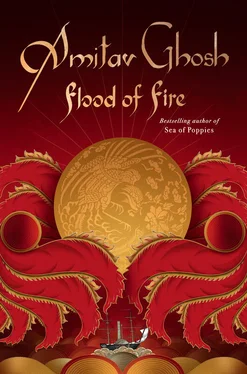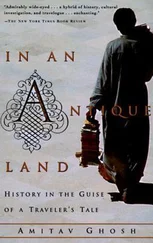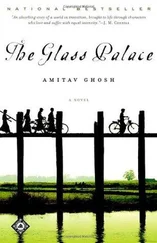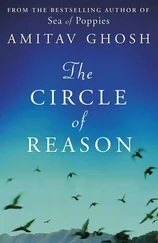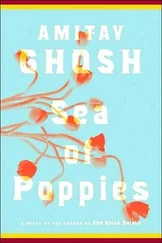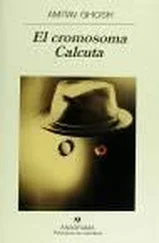As to the venue, I confess that I have been at something of a loss to decide on one — for a Discussion of this nature requires a degree of privacy that is hard to come by in a house that is as plentifully supplied with servants as ours. But at length I have hit upon a stratagem that will, I think, admirably serve the purpose. I have put it about that some of the shelves in my Sewing Room are broken and the nokar-logue have been informed that the Mystery-sahib will be coming to the house to repair them.
Today being Tuesday, I suggest you come to the front door of the house at 11 in the morning on Thursday. One of my maids will show you to my Sewing Room. Of course you must not neglect to bring your tools with you, and nor must you forget to bring the books that Dr Allgood has so kindly lent us — hundreds of people are clamouring for them, so great is the concern about this Epidemic.
Yours & c.
C. Burnham
p. s.: I enclose with this letter a packet of biscuits made to a recipe by the author of the Lecture on Chastity . They are said to be a marvellous antidote for your Disease, and are widely used as such in America, where they are known as ‘Graham Crackers’.
p. p.s.: needless to add, this note too should be destroyed as soon as it has been read.

Ht didn’t take long for Kesri to realize that the Pacheesi was a fiefdom for Bhyro Singh and his clan. Behind the battalion’s external edifice of military rank there lay an unseen scaffolding of power, with its own hierarchy and loyalties. This was not just tolerated but even encouraged by the battalion’s British officers, who relied on this fraternity to bring in new recruits and to pass on information about the men.
Not being a member of the clan, Kesri had to look elsewhere to learn about the Pacheesi’s inner workings. The man he turned to was a gifted but unlikely source of advice: none other than Pagla-baba, the Naga ascetic who travelled everywhere with the battalion.
Pagla-baba was thin and very tall, with limbs that looked as if they were made from fire-blackened bamboo. His joints were huge and gnarled, and his skin was smeared from head to toe with ash, as was his matted hair, which he wore on his head in a thick turban of coils. When the battalion was on the move, he marched with his earthly possessions on his back, slung on a length of rope — they consisted of a rolled-up mat, a set of three sharp-edged discs and a standard-issue brass lota, no different from those that were strapped upon the knapsacks of the sepoys. At the insistence of the battalion’s English officers he would sometimes wear a band of cloth around his waist, but when out of their sight he usually tucked it in so that it covered nothing. The ash was his clothing, he liked to say, and his genitals and pubes were daubed even more liberally with it than the rest of his body.
The English officers hated Pagla-baba and not just because he liked to bring the blush to their cheeks by flaunting his impressive manhood: they resented him for his hold on the soldiers and were flummoxed by his appeal. They never tired of pointing out to the sepoys that every paltan had its contingent of regimental pundits and maulvis to serve their religious needs; these functionaries were army employees, just like the Anglican chaplains who ministered to the officers, and the Catholic padres who tended to the battalion’s drummers, fifers and musicians (most of whom were Christian Eurasians and had entered the ranks through orphanages and poorhouses).
To the officers it was baffling that with so many respectable men of religion to turn to, the sepoys should resort instead to a naked budmash who didn’t even take the trouble to wear a langooty and went around with his artillery hanging out, as if to deliver a barrage.
What they didn’t understand was that as far as most sepoys were concerned regimental pundits and maulvis were important only for formal observances; when it came to their private hopes and fears, sorrows and beliefs, they needed messengers of a different kind. Ascetics like Pagla-baba were not just men of religion but also soldiers, and had served in armies and warrior bands. They understood the lives of sepoys in a way that no pundit or maulana ever could: they provided practical advice as well as spiritual guidance. In the battlefield, sepoys had much more faith in the protection of the amulets they received from faqirs and sadhus than in the blessings of pundits and imams.
It was also a great help that the ascetics were unusually well-informed: their networks extended everywhere and they frequently had access to better intelligence than the army’s spies. For all these reasons there was scarcely a battalion in Bengal that did not have an ascetic in its camp — and it didn’t matter what religion they professed to follow or whether they called themselves gosains or sufis. This too was a great annoyance to the Angrez officers for they liked to have people neatly in their places, with the Gentoos and Musselmen in their own corners.
Kesri was fortunate in being drawn into Pagla-baba’s inner circle through no effort of his own. It so happened that Pagla-baba had paid many visits to the annual mela that was held near Nayanpur. He had an astonishing memory for names and faces and he remembered having seen Kesri there, many years before. Because of that chance connection he took an interest in Kesri’s welfare from the time he entered the paltan — and Kesri, for his part, felt an instinctive affinity for Pagla-baba, largely because he made fun of pundits and purohits and all their endless observances of rules and rituals.
It was Pagla-baba who told Kesri about a way to get ahead in the paltan without having to depend on Bhyro Singh and his clan: volunteering for overseas service. Officers always took special note of a sepoy who volunteered, he said, because balamteers who were willing to travel on ships were hard to find in the Bengal Native Infantry. Most of the sepoys of the Bengal army were from inland regions like Bihar and Awadh, and they didn’t like to cross the sea: some felt that it compromised their caste standing; others objected to the additional expense as well as the inconvenience and danger. This was why overseas service was generally voluntary in the Bengal army: mandatory foreign deployments had led to disaffection in the past, so when troops were needed for missions abroad it was usually the Madras army that supplied them.
Yeh jaati-paati ki baat sab bakwaas haelba — all this talk of caste is bakwaas of course, said Pagla-baba, in his hoarse, crackling voice. When travel battas are offered, Bihari sepoys run like rabbits to sign up. The same if there’s any talk of prize money. Afterwards, they’ll pay for a little ceremony to remove the taint of crossing the black-water, and that’ll be that. Any sepoy will volunteer when there’s a glint of gold — but it’s when you sign up without any money on offer that the Angrez officers will really take notice of you.
Kesri would have volunteered at once if possible, but it took a while before an opportunity arose. One day the CO-sahib announced that balamteers were being sought to reinforce a British garrison on the Bengal-Burma frontier. The garrison was on an island called Shahpuri, at the mouth of the Naf River, which marked the border between the East India Company’s Bengal territories and the Burmese Province of Arakan. The island was a few hundred miles from Calcutta and the reinforcements were to be sent there by ship: this being just a spell of garrison duty, there were to be no special travel battas; nor was there any possibility of prize money or any other emoluments.
Kesri lost no time in putting his name on the list of volunteers — and since there were no financial incentives, he assumed that nobody else from his battalion would sign up as a balamteer. But when the full list was posted, it turned out that Hukam Singh had also volunteered, having been promised a temporary rank of naik, or corporal: worse still, Kesri was assigned to his very platoon.
Читать дальше
